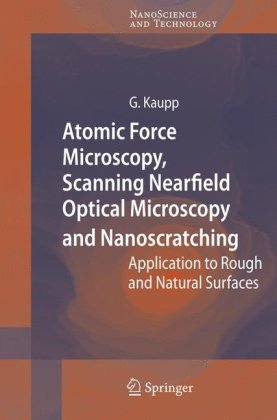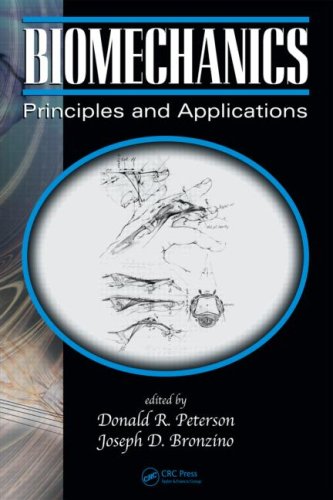Gerd Kaupp3540284052, 9783540284055
Table of contents :
Contents……Page 9
1.1 Introduction……Page 13
1.2 Basics of Contact AFM……Page 14
1.3 Instrumental……Page 15
1.4 Validity Checks……Page 21
1.5 Artifacts……Page 23
1.6 Surface Scratching and Plowing, Liquids on the Surface……Page 29
1.7 Molecular Steps……Page 34
1.8 Ambient Surface Modifications……Page 39
1.9.1 Volcano or Cone Type……Page 43
1.9.2 Islands……Page 44
1.9.3 Craters……Page 50
1.9.4 Pool Basin Type……Page 55
1.9.5 Prismatic Floes……Page 56
1.9.6 Heights and Valleys……Page 60
1.9.7 Fissures……Page 62
1.9.8 Bricks……Page 64
1.10 Shear-Force AFM……Page 68
1.11 Further Fields of Practical Application……Page 74
1.11.1 Biology and Medicine……Page 75
1.11.2 Pharmacy……Page 76
1.11.4 Ceramics……Page 77
1.11.5 Mineralogy and Geology……Page 78
1.11.6 Metallurgy and Corrosion……Page 80
1.11.7 Catalysis……Page 81
1.11.9 Historical Objects……Page 82
1.13 Conclusions……Page 83
References……Page 85
2.1 Introduction……Page 99
2.2 Foundations of SNOM……Page 100
2.3 Equipment……Page 107
2.4 Optical Resolution……Page 109
2.5 Dependence of the Reflectance Enhancement from the Shear Force……Page 114
2.6.1 Tip Breakage During Scanning……Page 118
2.6.2 Stripes Contrast……Page 120
2.6.3 Inverted Derivative of the Topology in the Optical Response……Page 122
2.6.4 Inverted Contrast……Page 124
2.6.5 Displaced Optical Contrast……Page 125
2.6.7 Topologic Artifacts……Page 127
2.7 Application of SNOM in Solid-State Chemistry……Page 130
2.8 Physical-State SNOM Contrast……Page 137
2.9.1 SNOM on Dental Alloys……Page 139
2.9.2 SNOM on Glazed Paper……Page 141
2.9.3 SNOM on Blood Bags……Page 144
2.9.4 Quality Assessment of Metal Sol Particles for SERS by SNOM……Page 146
2.10 Applications of SNOM in Biology and Medicine……Page 147
2.10.2 SNOM on a Human Tooth……Page 148
2.10.4 SNOM on Cryo Microtome Cuts of Rabbit Heart [61]……Page 151
2.10.5 SNOM on Stained and Unstained Shrimp Eye Preparations [61]……Page 156
2.10.6 SNOM in Cancer Research [61]……Page 158
2.11 Near-Field Spectroscopy……Page 161
2.11.1 Direct Local Raman SNOM……Page 162
2.11.2 SERS SNOM……Page 163
2.11.3 Near-Field Infrared Spectroscopy and Scanning Near-Field Dielectric Microscopy……Page 165
2.11.4 Fluorescence SNOM……Page 166
2.12 Nanophotolithography……Page 175
2.13 Digital Microscopy for Rough Surfaces……Page 180
2.14 Conclusions……Page 181
References……Page 183
3.2 Equipment……Page 189
3.3.2 Load–Displacement Curves……Page 191
3.3.3 Anisotropy and Far-Reaching Response……Page 194
3.4 Elastic and Plastic Parameters……Page 196
3.4.1 Nanohardness……Page 197
3.4.2 Reduced Elastic Modulus……Page 198
3.4.3 Contact Area and Contact Height……Page 199
3.4.5 The Unloading Iteration Process……Page 201
3.5 Improved Indentation Parameters……Page 205
3.6 Linear Plots for the Loading Curves – the New Universal Exponent 3/2……Page 210
3.7 Phase Transitions……Page 216
3.8 The Work of Indentation and its Anisotropy……Page 218
3.9 Recent Approaches to Nanoindentation at Highest Resolution……Page 222
3.10 Nanoindentations with Highly Anisotropic Organic Crystals……Page 223
3.11 Nanoindentations with Organic Polymers……Page 230
3.12 Concluding Remarks……Page 233
References……Page 235
4.1 Introduction……Page 240
4.2 Foundations of the Nanoscratching Technique……Page 243
4.3 Equipment……Page 245
4.4 The Appearance of Nanoscratches……Page 248
4.5.1 The Relation of Lateral and Normal Force……Page 249
4.5.2 Scratch Work Considerations and Mathematical Justification of the F[sub(L)] ~ F[sup(3/2)][sub(N)] Relation……Page 255
4.5.3 Phase Transitions……Page 257
4.5.5 Scratch Resistance……Page 263
4.5.6 Anisotropy in Nanoscratches……Page 266
4.5.7 Molecular Migrations in Anisotropic Molecular Crystals……Page 268
4.6 Scratching of Organic Polymers……Page 279
4.7 Conclusions……Page 284
References……Page 285
A……Page 289
C……Page 290
D……Page 291
E……Page 292
G……Page 293
K……Page 294
M……Page 295
N……Page 296
P……Page 297
S……Page 298
T……Page 300
V……Page 301
Z……Page 302







Reviews
There are no reviews yet.